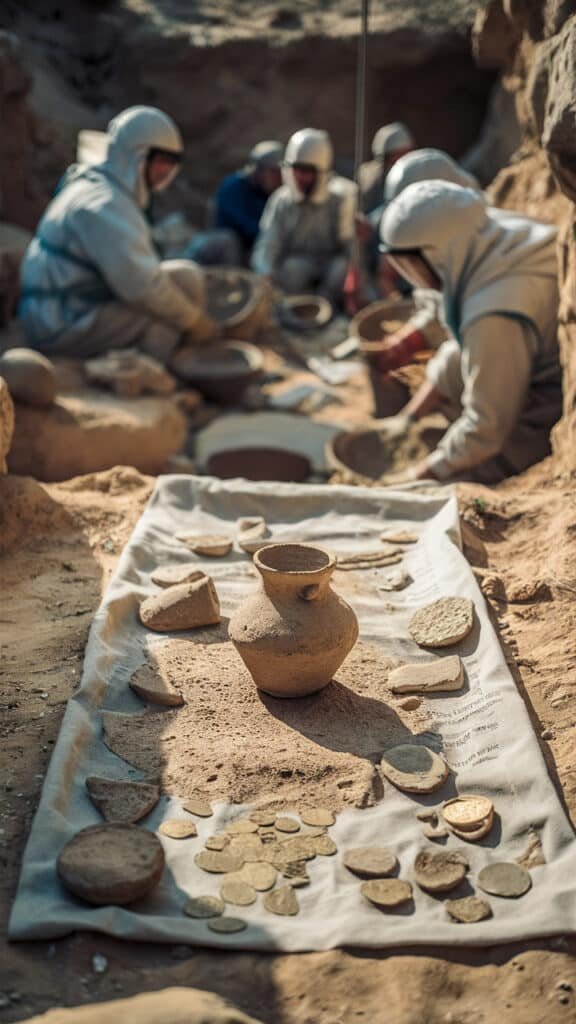The Bible is more than a spiritual guide—it’s a historical document woven into the fabric of ancient civilizations. While faith doesn’t require physical evidence, archaeological discoveries serve as a bridge for those seeking tangible connections between scripture and history. From the sands of the Middle East to the caves near the Dead Sea, these discoveries illuminate the Bible’s authenticity and deepen our understanding of its context.
1. The Dead Sea Scrolls: Preserving the Word Across Millennia
Discovered in 1947 in caves near Qumran, the Dead Sea Scrolls are among the most significant finds in biblical archaeology. These ancient manuscripts, dating back to the 3rd century BCE to the 1st century CE, include fragments from almost every book of the Hebrew Bible, as well as other writings.
The scrolls validate the textual reliability of the Bible, showcasing its preservation over centuries. For instance, the Great Isaiah Scroll aligns remarkably well with the Masoretic Text, which forms the basis of many modern Bible translations.
Spiritual Insight: These scrolls remind us that God’s Word stands the test of time, fulfilling Isaiah 40:8: “The grass withers, the flower fades, but the word of our God will stand forever.”
2. The City of David: Unearthing Biblical Jerusalem
Just outside the Old City walls of Jerusalem lies the City of David, an archaeological treasure trove. Excavations have revealed significant structures such as Hezekiah’s Tunnel, mentioned in 2 Kings 20:20, which was constructed to secure water during an Assyrian siege.
Recent findings include what some archaeologists believe to be remnants of King David’s palace, lending credibility to the biblical account of David’s reign. These discoveries bring to life the city at the heart of God’s redemptive plan.
Spiritual Insight: The City of David illustrates how God uses imperfect people, like David, to accomplish His purposes. It also reminds us of His faithfulness to Jerusalem throughout history.
3. The Tel Dan Inscription: Confirming the “House of David”
For years, skeptics questioned the historical existence of King David. That changed in 1993 with the discovery of the Tel Dan Inscription in northern Israel. This 9th-century BCE stone fragment contains the phrase “House of David,” marking the first non-biblical reference to David as a historical figure.
This discovery corroborates biblical accounts and strengthens the historical foundation of Israel’s monarchy as described in 1 and 2 Samuel.
Spiritual Insight: The Tel Dan Inscription encourages us to trust God’s Word, even when evidence seems scarce. As Jesus said, “Blessed are those who have not seen and yet have believed” (John 20:29).
4. The Pool of Siloam: A New Testament Connection
Unearthed in the early 2000s, the Pool of Siloam in Jerusalem is directly linked to Jesus’ miracle of healing the blind man in John 9:1–7. Archaeologists confirmed its location, validating the Gospel account of Jesus sending the man to wash in the pool to restore his sight.
Spiritual Insight: This discovery reminds us that God’s works often require simple acts of faith and obedience. Just as the man was healed through his trust in Jesus, so can we experience restoration when we walk in faith.
5. Jericho’s Walls: A Story of Faith and Fulfillment
The ruins of Jericho and its collapsed walls offer an intriguing connection to the biblical account in Joshua 6. Evidence suggests the walls fell outward rather than inward—an unusual occurrence that aligns with the miraculous nature of the story.
While scholars debate the precise timing, the find invites believers to explore how archaeology and faith intersect.
Spiritual Insight: Jericho’s story reminds us that God can bring down the walls in our lives through faith and obedience, just as He did for Israel.
6. The Pontius Pilate Inscription: Anchoring the New Testament
In 1961, archaeologists discovered a stone inscription in Caesarea Maritima bearing the name and title of Pontius Pilate, the Roman governor who sentenced Jesus to death. This find confirmed his historical existence and role in Judea, as described in Matthew 27:11–26 and other Gospels.
Spiritual Insight: Pilate’s inscription challenges us to reflect on our response to Jesus. Will we wash our hands of Him, as Pilate did, or embrace Him as our Savior?
The Bigger Picture: Why These Discoveries Matter

These archaeological finds do more than validate the Bible’s historical reliability; they help bridge the gap between faith and skepticism. While archaeology doesn’t “prove” the Bible, it often confirms its plausibility, offering tangible connections to God’s story.
For believers, these discoveries deepen trust in the Bible’s accuracy. For skeptics, they open the door to exploring the scriptures with fresh curiosity. And for all of us, they provide a glimpse into the God who works in real time and space, using people and events to accomplish His redemptive plan.
Taking the Next Step
These discoveries inspire awe, but they also invite action. Consider exploring biblical history further through:
- Visiting museums like the Bible Lands Museum in Jerusalem or the British Museum in London.
- Reading books like The Archaeology of the Bible by James K. Hoffmeier.
- Engaging in a Bible study that connects scripture with history.
Final Thought
While faith is about believing in what we cannot see (Hebrews 11:1), archaeology serves as a signpost pointing to the divine Author of history. These discoveries remind us that the Bible isn’t just a spiritual text—it’s a record of God’s interaction with humanity, written in the very dust and stones of the earth.
Let these treasures of the past inspire your faith, deepen your trust in God’s Word, and encourage you to dig into His truth. After all, the discoveries of today are just the beginning of the wonders yet to be revealed.



